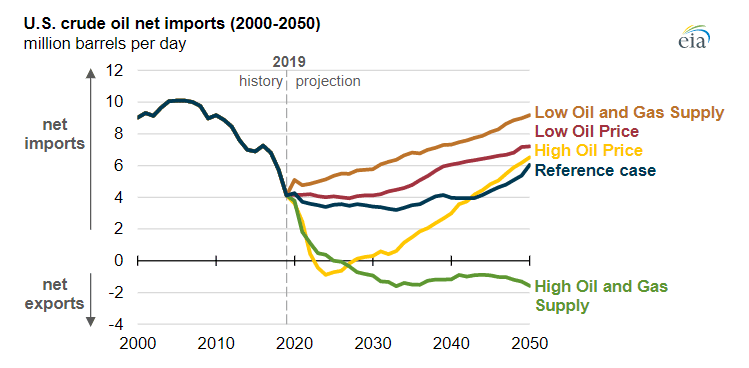U.S. Projected to be a Net Exporter of Crude Oil and Petroleum Combined Until 2050: EIA

The U.S. is projected to export more crude oil and petroleum combined than it imports until 2050, according to the U.S. Energy Information Administration’s Annual Energy Outlook 2020. In two scenarios, one with more oil and gas supply and the other with higher oil prices, the agency expects the nation to become a net exporter of crude oil on its own within the next decade.
- In the reference case, the U.S. will remain a net crude oil importer through 2050 despite production increases; the agency expects production to increase from about 12 million barrels per day in 2019 to plateau at 14 million b/d in the mid-2020s, and then begin to fall in the mid-2040s.
- In a high oil and gas supply case the agency projects the U.S. to become a net crude oil exporter as early as 2025 and to maintain that status through 2050, with production reaching 18 million b/d in 2026 and remaining higher than that level over the projection period.
- When analyzing a high oil price case the projections are for the U.S. to become a net crude oil exporter starting in 2023 but only maintaining that status through 2027;production peaks at 19 million b/d in 2025 and then declines through 2050.
The recent growth of domestic crude oil production has been driven by the development of tight oil resources, primarily in the Southwest which includes the Permian Basin. The agency expects development to continue in the Southwest, which is projected to account for 37 percent of the cumulative production from 2020-2050 in the reference case. Despite the change in production volume in other cases, the cumulative crude oil production remains unchanged over that period.
EnerKnol Pulses like this one are powered by the EnerKnol Platform—the first comprehensive database for real-time energy policy tracking. Sign up for a free trial below for access to key regulatory data and deep industry insights across the energy spectrum.
ACCESS FREE TRIAL